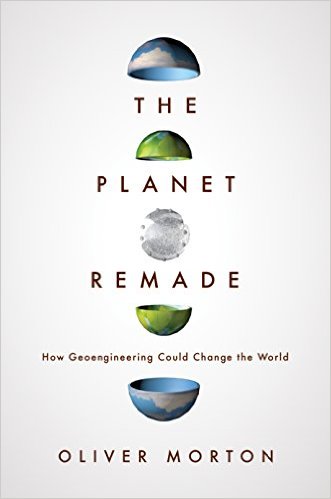 Oliver Morton, author of The Planet Remade: How Geoengineering Could Change the World, is a radical thinker. However, he’s level-headed too. The Planet Remade discusses the various ways to avert an ecological catastrophe.
Oliver Morton, author of The Planet Remade: How Geoengineering Could Change the World, is a radical thinker. However, he’s level-headed too. The Planet Remade discusses the various ways to avert an ecological catastrophe.
The book is divided into 3 parts: energies, substances, and possibilities.
The first looks at the world's natural state—documenting the vast amount of energy on the planet. For example, humans consume 15 terawatts per year. That seems like a lot. However, when you add up all the energy on the planet, you learn that there are 120,000 terawatts.
The second part examines our current state. The final section considers the potent geoengineering angles.
Morton begins by asking two questions:
1) Do the risks of climate change merit taking severe action to lessen the risk?
2) Is it tough to reduce our emissions to near zero?
He ultimately answers “yes” to both of those questions.
Morton spends the rest of The Planet Remade illustrating the scale of the problem. For example, Morton writes:
There are many reasons why deep global cuts to carbon dioxide are difficult to achieve. . . . One is that fossil fuels are built into the foundations of the industrial and economic system, which means cutting emissions is hard—especially since the costs of the cuts are concentrated on a powerful sector of the economy. The other is that cutting carbon dioxide provides no short-term benefits. Because what matters to the climate is the total amount of carbon dioxide in the atmosphere, not the rate at which it is inherited, carbon dioxide cuts made today will have more or less no effects on climate for thirty years. History hangs over everything. This, perhaps more than anything else, is what makes climate negotiations difficult; costs people bear now lead to benefits that other people will see in the second half of the century.
He’s also well aware of Malthusians who have always been wrong. He quotes Vogt, who said long ago, “It is obvious that 50 years hence the world cannot support three billion people at any but coolie standards.”
Therefore, Morton is wise not to underestimate human ingenuity. As I argue in The Hidden Europe, We may well cram 10, 50, or even 100 billion humans on this rock. Reproducing as much as possible is the duty of life.
In addition to not underestimating human ingenuity, The Planet Remade reminds the reader that dramatic climate changes happened quickly long before the Industrial Age.
In the far south of Algeria, on a plateau of wind-carved sandstone called Tassili n’Ajjer, there is a remarkable collection of rock art—thousands of pictures of elephants, crocodiles, ostriches and gazelles, and of people living among them as happy hunters, even pastoralists. They are less than 10,000 years old. In the early-to-middle Holocene, the temperature difference between summers and winters in the northern hemisphere was greater than it is today.” This would have “pulled the West African monsoons . . . much farther north” than it today so that some Sahara rivers would empty into the Mediterranean. Lake Chad was far larger—nearly the size of the Caspian Sea and more than all of America’s Great Lakes combined. “The canoes used by the fishing people living on its shores were as large and sophisticated as those seen on the Mediterranean.
We didn’t need SUVs to see such a change. I debated such issues extensively with a dinosaur. Still, the doomsday prophet will declare, “Yeah, but now it’s happening at an unnatural rate.”
To which The Planet Remade responds: “Around 6,000 years ago, today’s desert conditions established themselves with striking speed. . . . All that was left to record the plenty that had gone before was pollen, bones and those plaintive paintings.”
Significant climate change happened in a couple of decades. Morton writes:
The suddenness of the change, some scientists think, is evidence that there was some sort of amplification at play. When the Sahara, or large parts of it, were green, the plants were not just benefiting from the wetter climate—they were helping to maintain it, by holding together the soil and pumping rainwater back to the sky through their leaves, thus encouraging convection that cooled the surface created clouds. They kept doing this even as summer temperatures fell and the monsoon shifted to the south until a dry cooling around 6,000 years ago dealt the system its death blow; the drying made life more difficult for the vegetation, which led to further drying, which killed off yet more of the plants. Patches of desert spread and merged.
The Planet Remade is refreshing because it doesn’t just say it’s all doom and gloom. He points out that global warming has a chance of turning many parts of the Sahara back into a verdant place:
In a world with a higher carbon dioxide level, and thus more water-efficient plants, this process might be reversed; various models suggest that global warming could, in time, lead to a new greening of at least parts of the Sahara. More plants would mean more water vapor, more clouds and rain, and thus more plants—the feedbacks that brought the desert about now running in reverse. . . . The vast dried basins of the desert could be refilled.
Few in the climate change debate acknowledge that we’re living in an interglacial period of a long ice age. Yes, we’re in an ice age right now, with brief (10,000-year) periods where there’s temporary warming. Since it’s been relatively warm for 10,000 years, we’re due to return to a glacial period of this ice age (which lasts around 100,000 years). A glacial period would be far more devastating to life (especially human life) than further warming. In fact, in the 1930s, some were happy that industrialization would help thwart the looming glacial period.
Arrhenius saw the effect of industrial fossil-fuel burning on the climate as largely benign. Guy Callendar, a British scientist who followed up on Arrhenius’s work in the 1930s, was happy to conclude that the use of fossil fuels would postpone the next ice age—“the return of the deadly glaciers sould be delayed indefinitely.”
It’s crucial not to misunderstand The Planet Remade. After reading this review, you might conclude that Morton is minimizing climate change or believes that geoengineering our planet will easily solve all our problems.
Absolutely not.
I’m simply quoting some interesting passages to show how balanced this book is. In a world filled with doomsday books or climate deniers, The Planet Remade is a refreshing look at the challenge.
Morton advises us that remaking the planet using geoengineering is fraught with pitfalls. But at the same time, he argues persuasively that we must consider them since we ignore them at our peril.
The only thing I disliked about it is that there was too much history—Morton ought to spend more pages looking forward rather than looking backward. Also, he gets into the weeds of detail that will overwhelm the average reader.
Still, if you want to read some innovative solutions to climate change, then The Planet Remade should be on your bookshelf.
VERDICT: 8 out of 10 stars.




